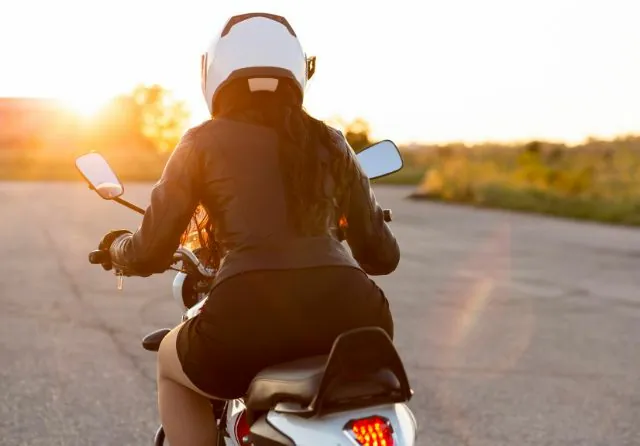Riding a scooter is the perfect way to discover corners in every city you are visiting. This form of transport provides great freedom of movement, and allows a closer and more direct contact with the place.
However, not everyone knows how to ride a scooter. That's why, in this article, we share with you some basic guidelines to get you started with this vehicle.
Table of Contents
TogglePreparations before riding a scooter
In this section we want to talk about two very important issues: equipment and basic controls.
Equipment needed to ride a scooter
Although it may seem like an excessive precaution, we believe it is very important to have the right equipment when riding a scooter for the first time. Being well equipped will help you to eliminate insecurities and focus on the important aspects of riding. Here is our recommendation:
- Helmet: Mandatory and essential to protect the head.
- Gloves: They help improve grip and protect the hands.
- Appropriate clothing: Choose clothing that covers the body well and protects you from wind and possible falls.
- Closed shoes: Avoid sandals or open-toed shoes; it is best to wear shoes that cover your feet well.
Know the basic controls of a scooter
Before you start, familiarise yourself with the basic controls for confidence and safety. Here's a quick guide:
- Throttle: Generally located on the right hand grip; turn it towards you to accelerate.
- Brakes: Normally, the front brake is on the right brake lever and the rear brake on the left brake lever.
- Lights and indicators: Investigate how to turn lights on and off, as well as direction indicators.
- Horn: This is usually located near the handlebars and is important for your safety and the safety of other vehicles/pedestrians.
- Rear-view mirrors: Adjust the mirrors to get a good view of what is going on behind you.
With these first recommendations, we are now ready to get the scooter on the road!

First steps to riding a scooter
How do I start a scooter? How do I keep my balance? These are very common questions, so here are some recommendations:
How to start a scooter
This guideline may seem like a no-brainer, but if you have never ridden a motorbike before, you may find it useful. Follow the steps below:
- Stand the scooter upright: Use the centre or side stand to support the scooter.
- Turn the key: Insert the key into the ignition and turn it to the start position.
- Press the brake: Hold down the rear brake for safety.
- Press the start button: While holding the brake, press the start button (usually located on the right handlebar).
- Release the brake: Once the engine is running, release the rear brake.
- Accelerate gently: Once the engine is running, twist the throttle gently to start moving.
Balance and posture techniques
As you can imagine, maintaining good balance and proper posture is essential when riding a scooter. Here are a few tips:
- Sit correctly: Make sure you are sitting properly, with your back straight and both feet flat on the platform.
- Keep your arms relaxed: Avoid tensing your arms; keep them flexible so you can manoeuvre easily.
- Look ahead: Keep your eyes on the road and traffic, not on the front wheel.
- Use your body for balance: In bends and turns, lean your body slightly in the direction of the turn to maintain balance.
- Practice in a safe area: Before hitting the road, practice these techniques in a quiet place without traffic to gain confidence.
Basic scooter driving
How to ride a scooter in different conditions
It's not the same to drive a car on a city road as on a country road, is it? It's the same with a scooter. Every context and every climate has its own requirements, so it's important to adapt your riding accordingly.
Urban vs. rural road
In an urban environment, it is important to maintain a constant speed within the posted limits and to use your rear-view mirrors at all times. Anticipation is a key element: plan and indicate your movements. Also, be alert to react to possible obstacles: pedestrians, traffic lights and other vehicles.
Rural roads change driving completely. Here, you should maintain a moderate speed, and watch out for bends and changes in the terrain. Less travelled roads can hide surprises, such as animals or cyclists.
Soil wet by rain vs. dry soil
If the road is wet, reduce your speed and increase your braking distance. Do not brake sharply and make smooth movements with the scooter's controls to maintain control. In these conditions, use the brakes progressively and avoid sharp turns. In addition, we advise you to wear waterproof clothing and gloves.
Driving on dry roads provides greater traction and control, but you should not let your guard down. Drive safely and responsibly, using the brakes properly and obeying traffic signs.
How to ride a scooter for the first time
How to ride a scooter for the first timeStart by finding a safe, large, traffic-free area where you can practice without distraction or risk. In this space, start by accelerating gently and familiarising yourself with the scooter's response. Take time to understand how the brakes work by practising controlled braking, and using both the front and rear brakes.

A medida que te sientas más cómodo, empieza a practicar giros (derecha e izquierda). Comienza con giros amplios y gradualmente realiza giros más cerrados. Mantén siempre una postura relajada y utiliza tu cuerpo para acompañar el movimiento de la scooter, especialmente en las curvas.
La confianza es clave para una conducción segura. A medida que vayas mejorando, intenta conducir en calles con un poco más de tráfico y variando las condiciones del camino. Esto te ayudará a adaptarte a diferentes escenarios y te preparará mejor para manejar en la variedad de situaciones que Gran Canaria te puede ofrecer.
Essential skills and manoeuvres
How to brake a scooter correctly
Braking correctly is one of the most important skills when learning to ride a scooter. Use both brakes (front and rear) progressively to stop safely. It is essential to avoid harsh braking as this can cause the wheels to lock up and the scooter to skid. In emergency situations, apply firm and steady pressure on both brakes while keeping the scooter straight. Practice controlled braking in different conditions to familiarise yourself with the scooter's response and gain confidence.
Turning and changing lanes
When turning, slow down before the turn and use your body to lean slightly in the direction of the turn. Keep your eyes on the exit of the turn and not on the front wheel.
When changing lanes, check your mirrors and turn your head to check the blind spot. Use your turn signals well in advance to inform other drivers of your intentions. Make lane changes gradually and smoothly, avoiding sudden movements that could destabilise the scooter. Practising these manoeuvres in a controlled environment will help you to perform them confidently and safely in real traffic.
Basic maintenance for beginners
Basic check-ups and care
As a beginner, familiarise yourself with basic maintenance tasks such as checking oil levels and changing oil according to the manufacturer's instructions. Check tyre pressures regularly for good grip and performance. Check the brakes, making sure the brake pads are not worn and that the brake fluid is at the correct level. Don't forget to check lights and indicators to ensure they are working properly.
If you follow our tips and techniques, you will soon be riding a scooter! To start your adventure on two wheels now, Scooter & Bike can provide you with the 125 scooter you need. With a wide selection of well maintained scooters, at Scooter & Bike we make sure you get the most out of your experience in Gran Canaria, rent your scooter with us!




